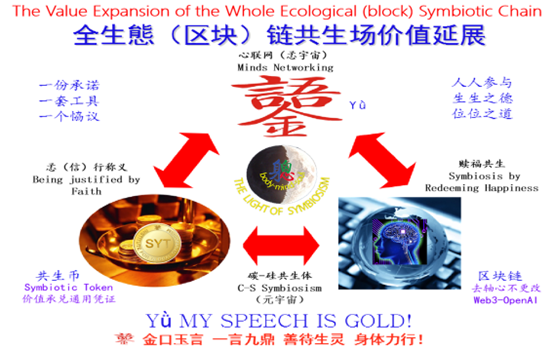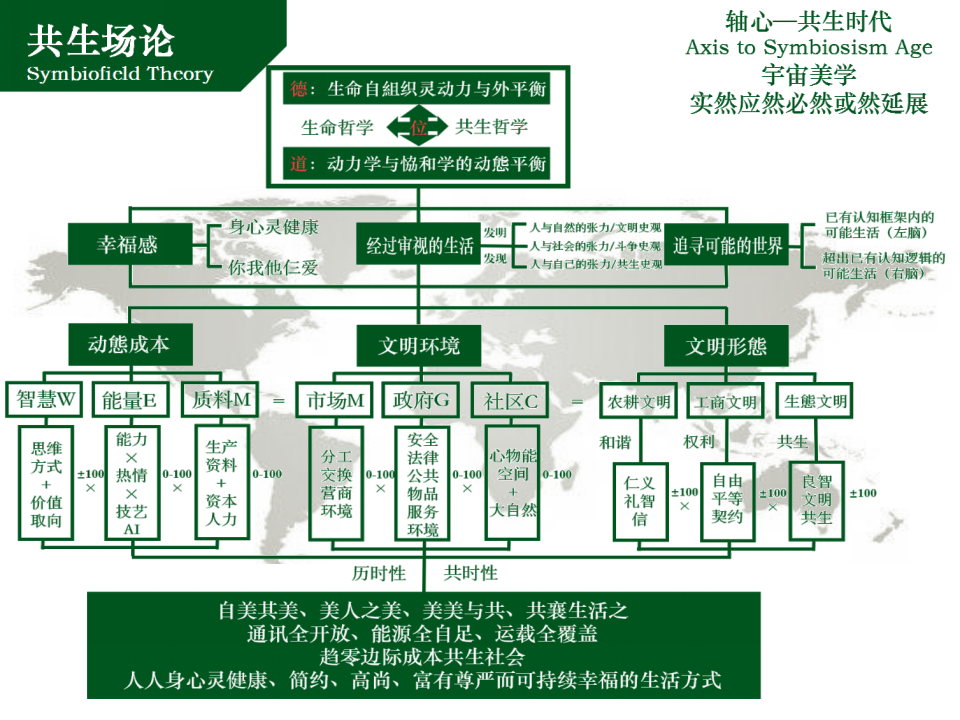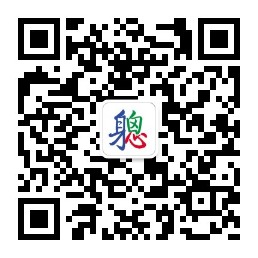New Articles
-
 迈向新世界秩序:以社区生态主权取代地缘政治... 2025/06/23
迈向新世界秩序:以社区生态主权取代地缘政治... 2025/06/23Towards a New World Order: Replacing Geopolitical Sovereignty with Community Ecological Sovereignty迈向新世界秩序...
-
 遣返、消化、改变三大策略并举 2025/06/12
遣返、消化、改变三大策略并举 2025/06/12Deportation, Integration, and Transformation: Three Concurrent Strategies to Address Illegal Immigration 解决“非法移...
-
 川普与马斯克的和解空间 2025/06/08
川普与马斯克的和解空间 2025/06/08川普与马斯克的和解空间 Reconciliation Space Between Trump and Musk ——假如把《大而美法案》改为:Slim and B...
-
 重新定义企业家在文明中的角色 2025/06/03
重新定义企业家在文明中的角色 2025/06/03Redefining the Role of Entrepreneurs in Civilization重新定义企业家在文明中的角色 By Archer Hong Qian &n...
共生思想理论前沿
THE THEORY
-

-

-

-
 关于中文“共生”翻译及对应的人、事、物之说明
关于中文“共生”翻译及对应的人、事、物之说明关于中文“共生”翻译及对应的人、事、物之说明 ——Symbiosism:Charles Thomas Taylor &Qian hong又一次量子缠绕...
查看详细说明
Speech
-
 三大自组织货币的共生格局——宏观世界之数字货币 2021/07/08
三大自组织货币的共生格局——宏观世界之数字货币 2021/07/08三大自组织货币的共生格局 ——宏观世界之数字货币 钱 宏 The Institute for Global Symbiosism(...
-
 新汉字yǜ的释义 2019/11/16
新汉字yǜ的释义 2019/11/16语从金音玉(Yǜ):金口玉言,一诺千金,性人诚恳、执信; &n...
-
 钱宏:中国的真实经验与未来走向(凤凰博报专... 2019/11/16
钱宏:中国的真实经验与未来走向(凤凰博报专... 2019/11/16点击播放 中国的真实经验与未来走向《凤凰博报》专访钱宏主持人:...
从GDP到GDE:思想银行与共生币的时代来临
发布时间:2025/05/13 公司新闻 浏览次数:97
从GDP到GDE:思想银行与共生币的时代来临
——《全球化3.0行为指南》补充文本
Archer Hong Qian
引言
随着全球化2.0的终结,那一套以资本增值/减值为轴心,用来核算国民经济绩效的GDP价值参量,正在失去其制度性效度与文明合法性。它所代表的,不仅是一种过时的会计逻辑,更是一种价值观的滞后。
而当全球化进入3.0时代,一个以结构性协调、能效比改善、行为责任共担为内核的新文明正在浮现。相应地,用于衡量国民行为效能、评估资源“能效/能耗状态”的GDE(Gross Domestic Efficiency)价值参量,将自然取代GDP,成为新阶段的主轴。
这一价值跃迁,必然带出行为-资源-价值-责任之间更精细、更实时的交互机制。
于是,“共生币”作为一种孞念奖抑机制所承兑的交互价值凭证,便不再仅仅是货币形态的延续,而是行动与动机之间、资源与关系之间、伦理与技术之间的桥梁。
而与“共生币”机制相辅相成、深度嵌套的——必然是一个全新的认知基础设施:
思想银行(MindBank)——一个存储、评估、放贷和激活孞念能量的结构性平台。
这个“银行”不会被金本位所约束,也不会被国家主权所垄断,它以孞之真实为底,以交互主体共生为律,以五因交互指数价值结构为准绳,为每一个人、每一份思想、每一笔行动,建立属于未来的价值评估与孞息平衡表。
全球化3.0的真实起点,或许就从思想存款与共生兑付的重新定义开始。
微笑之中,真理浮现。
《川普团队重构全球化3.0建议与行动指南》(以下简称《行动指南》)指出,全球化2.0的制度性危机源于“三重不可能三角”(国家主权、公民人权、全球化自由贸易的矛盾),需要通过“可能三角”(生命自组织连接力、社会生活繁荣、全球共生永久和平)构建全球化3.0的共生经济体系。本补充文本基于《行动指南》的核心理念,结合GDE(Gross Domestic Efficacy)“五因交互指数”(C降本、E赋能、H健康、T孞托、P和平)、“五维结构评级”(制度开放性、财政透明性、盈余循环效率、人与自然兼容性、资源流通效率)、“五体跃迁指数”(国家主权重塑、民权参与激活、信任体系重构、社会能产转换、奖抑机制健全)三大共生指数,细化GDE健康率统计、共生币和思想银行的实施框架,推动全球化3.0从“单向规则”向“三重规则”(道德、法制、共生)的历史转型,最终实现信仰、契约、平等、公益=在God面前Intersubjective Symbioaiam的永久和平!
第一部分:基于五因事件指数的GDE统计体系
1.1 GDE共生指数与五因交互
《行动指南》提出,GDE共生指数是全球化3.0的核心评估工具,旨在取代GDP(国内生产总值),以“健康黄金率”(健康价值)轻松经济活动的共生效能。结合“五因交互指数”,GDE的计算公式为:

五因素定义如下:
- C(降本):组织熵减少翻新,消除浪费欺骗,保障关键财政服务,恢复国家或企业的财政健康(例如,《行动指南》提到美国2024年ODY赤字1.2万亿美元,需通过熵减少财政优化)。
- E(赋能):激发生命自组织力,释放权能,促进主体互动创新(例如,《行动指南》提出的“仨自组织人”(你、我、他政经文)通过自组织力替代“理性经济人”)。
- H(健康因数):评估政策对社会生活、生态及生命身心灵健康的影响(例如,《行动指南》强调以生命价值为核心的治理模式)。
- T(孞托结构):体现制度的公民孞心、国际孞声誉和资本孞托度(例如,《行动指南》提到提升贸易伙伴的制度透明度以增强信任)。
- P(和平)保障:通过法律、正义和公平社会稳定(例如,《行动指南》通过四边机制提出人权和知识产权)。
1.2 GDE统计方法的细化
- 数据采集:
- C(降本):利用“孞态网”(Mindset Network,MN)监测组织熵减少和浪费减少(例如,通过区块链追踪供应链透明,消除欺诈)。
- E(赋能):统计交互主体创新数据(例如,《行动指南》提到的“仨自组织人”在政治、经济、文化领域的自组织行为)。
- H(健康因数):结合生态足迹、社会生活质量和人体健康数据(例如,参考《行动指南》中11国结构转型评估的生态指标)。
- T(孞托结构):通过公民信任调查、国际舆论指数和资本流动数据评估(例如《行动指南》提到的通过国际孞誉提升信任)。
- P(和平):参考全球和平指数(GPI)和基础公平数据(例如,《行动指南》提出的全球共生竞赛)。
- 计算流程:
- 标准化五因数据(0-1)。
- 代入公式计算健康值,作为GDE基础值。
- 结合《行动指南》中“五维结构评级”,得出国家或地区的GDE指数。
- 国际标准化:建议通过《行动指南》提出“共生经济全球评估”(SGE),推动GDE成为全球评估标准。
1.3 实施路径
- 短期(2025-2026年):结合《行动指南》建议,美国率先在2026年举办SGE,关注GDE统计,验证“可能三角”的吸气。
- 中期(2026-2035年):通过全球共生论坛(GSF),推广GDE工具,纳入“孞态网”技术支持。
- 长期(2035年及以后):实现《行动指南》目标,全面取代GDP,引领全球治理范式转型。
第二部分:共生币的五因激励机制
2.1 共生币与五因交互
《行动指南》提出“得币、法币、共生币”的货币跃迁,共生币作为全球化3.0的交换价值承兑依据,基于五因交互指数激励共生行为:
C(降本):奖励组织熵减少和消除欺诈的行为(例如,《行动指南》提到的制度改革提升可以通过共生币激励)。
E(赋能):奖励交互主体创新(例如,支持“仨自组织人”的经济自组织行为)。
H(健康因数):支持改善社会生活和身体健康的政策(例如,《行动指南》强调生命价值保护)。
T(孞托结构):激励提升公民孞心和国际孞誉的行为(例如,《行动指南》提出的跨文化信任建设)。
P(和平):奖励促进公平和正义的行动(例如,《行动指南》提到的四边保障机制人权)。

2.2 技术实现
“孞态网”支持:《行动指南》提出的“孞态网”(NET × IoT × MN)通过信息定价(NET)、装备自动化(IoT)和主体行为交互(MN),记录五因数据。
动态反馈:《行动指南》中“孞态状态感应”机制,利用“孞态曲线”分析行为变化,动态分配共生币奖励。
争议案例:结合《行动指南》建议,在SGE中争议共生币,奖励符合五个因平衡的创新项目。
2.3 实施路径
短期(2025-2026年):在SGE中参与共生币发行,结合“孞态网”技术。
中等(2026-2035年):扩展至全球贸易,支持《行动指南》提出的“动态平衡贸易”。
长期(2035年及以后):推动共生币成为《行动指南》中“共生经济”的全球通用凭证。
第三部分:思想银行的五因驱动构建
3.1思想银行与五因交互
思想银行作为行动指南》中“爱之智慧”(Amorsophia)的技术载体,基于五因交互指数,激励科幻资本和共生协作:
C(降本):通过“孞态网”降低知识共享中的浪费和欺诈(例如,消除学术不端)。
E(赋能):激发交互主体的知识创新(例如,支持《行动指南》中“仨自组织人”的文化自组织)。
H(健康因数):促进生态和身体健康的研究(例如,《行动指南》提出的文明交流计划)。
T(孞托结构):提升知识平台的公民孞心和国际孞誉(例如,《行动指南》提到的跨文化信任建设)。
P(和平):支持公平和正义的知识传播(例如《行动指南》提出的《全球共生竞赛》)。
3.2 技术与治理
技术架构:依托《行动指南》中“孞态网”(NET × IoT × MN),构建去中心化的思想存储和流通系统。
治理机制:通过《行动指南》提出的“共生权范式”,建立DAO(去中心化自治组织),基于五因指数评估思想贡献。
3.3 实施路径
短期(2025-2026年):结合SGE,聚焦思想银行,记录共生经济创新成果。
中期(2026-2035年):延伸至全球共生论坛(GSF),支持《行动指南》中的文明互动计划。
长期(2035年及以后):构建全球思想银行联盟,推动《全球共生》的文化宣传。
第四部分:全球化3.0的五因协同推进
4.1 五因推动的跨协作领域
《行动指南》通过“共生经济全球劳动力”(SGE)和《全球共生劳动力》推动全球化3.0提出,五因协作如下:
政府:通过降本(C)和孞托结构(T),优化财政健康和公民信任(例如,《行动指南》提到的互星美视政策优化)。
企业:通过赋能(E)和和平(P),推动创新和公平协作(例如,《行动指南》提出的动态平衡贸易)。
公众:通过健康因数(H),提升生态和心灵健康意识(例如,《行动指南》提到的文明交流计划)。
4.2 风险与应对
制度框架:《行动指南》指出需消除制度漏洞,通过“孞态网”确保数据透明。
社会稳定:结合《行动指南》建议,通过三重规则提升政策间隙,减少社会摩擦。
4.3愿景展望
基于《行动指南》的目标,GDE、共生币和思想银行将推动全球化3.0从“增长黄金率”向“健康黄金率”转型,实现“以生命价值为核心”的共生经济,开启公平共生、永久和平的新阶段。
From GDP to GDE: The Dawn of the Mindset Bank and Symbiotic Tender Era
Supplemental Document to the Action Guide for Globalization 3.0
Archer Hong Qian
Introduction
With the conclusion of Globalization 3.0 (全球化3.0), the GDP (Gross Domestic Product, 国内生产总值) value metric—centered on capital appreciation and depreciation to assess national economic performance—is losing its institutional validity and civilizational legitimacy. It represents not only an outdated accounting logic but also a lag in values.
As globalization enters its 3.0 era, a new civilization is emerging, driven by structural coordination, improved energy efficiency ratios, and shared behavioral responsibility. Accordingly, the GDE (Gross Domestic Efficiency, 国内效率总量) value metric, which measures national behavioral efficiency and evaluates the “energy efficiency/energy consumption state” (能效/能耗狀態) of resources, will naturally replace GDP as the central framework for this new phase.
This value transition inevitably introduces a more refined and real-time interaction mechanism among behavior, resources, value, and responsibility.
Thus, the “Symbiotic Tender” (共生币, Symbiotic Coin), as an interaction value endorsement credential under a mindset reward-constraint mechanism (孞念奖抑机制), transcends its role as a mere continuation of currency forms. It becomes a bridge between actions and motivations, resources and relationships, and ethics and technology.
Complementing and deeply integrated with the Symbiotic Tender mechanism is a new cognitive infrastructure: the Mindset Bank (思想银行, MindBank)—a structural platform for storing, evaluating, lending, and activating mindset energy (孞念能量).
This “bank” is neither constrained by the gold standard nor monopolized by national sovereignty. It is grounded in the authenticity of mindset (孞之真实), governed by the principles of intersubjective symbiosis (交互主体共生), and guided by the value structure of the Five-Factor Interaction Index (五因交互指数). It establishes a future-oriented value assessment and mindset balance sheet for every individual, every thought, and every action.
The true starting point of Globalization 3.0 may well begin with the redefinition of thought deposits and symbiotic endorsements.
In this light, truth emerges with a smile.
The Proposal and Action Guide for the Trump Administration to Restructure Globalization 3.0 (hereinafter referred to as the Action Guide, 《川普团队重构全球化3.0建议与行动指南》) identifies the systemic crises of Globalization 2.0 (全球化2.0) as stemming from the “Triple Impossible Triangle” (三重不可能三角)—conflicts among national sovereignty (国家主权), civic human rights (公民人权), and global free trade (全球化自由贸易). It advocates for the establishment of a “Possible Triangle” (可能三角)—Life Self-Organization Connection Capacity (生命自组织连接力), Social Prosperity (社会生活繁荣), and Global Symbiotic Permanent Peace (全球共生永久和平)—to construct a symbiotic economic system (共生经济体系) for Globalization 3.0. This supplemental document builds on the core concepts of the Action Guide, integrating the GDE framework with three symbiotic indices: the “Five-Factor Interaction Index” (C: Cost Reduction/降本, E: Empowerment/赋能, H: Health Factor/健康因子, T: Trust Structure/孞托结构, P: Peace Factor/和平因子), the “Five-Dimensional Structure Rating” (五维结构评级: Institutional Openness/制度开放性, Fiscal Transparency/财政透明性, Surplus Circulation Efficiency/盈余循环效率, Human-Nature Compatibility/人与自然兼容性, Resource Flow Efficiency/资源流通效率), and the “Five-Body Transition Index” (五体跃迁指数: National Sovereignty Reshaping/国家主权重塑, Civic Participation Activation/民权参与激活, Trust System Reconstruction/信任体系重构, Social Energy Production Transformation/社会能产转换, Reward-Constraint Mechanism Enhancement/奖抑机制健全). It elaborates on the implementation frameworks for GDE Health Rate accounting (GDE健康率统计), Symbiotic Tender, and the Mindset Bank, driving the historical transition of Globalization 3.0 from “unilateral rules” (单向规则) to “triple rules” (三重规则: morality/道德, legality/法制, symbiosis/共生). The ultimate goal is to achieve faith, covenant, equality, and public good—embodying Intersubjective Symbioaiam before God, ensuring permanent peace.
Section 1: GDE Accounting System Based on the Five-Factor Interaction Index
1.1 GDE Symbiosis Index and Five-Factor Interaction
The Action Guide positions the GDE Symbiosis Index as the core evaluation tool for Globalization 3.0, aiming to replace GDP by measuring the symbiotic efficiency of economic activities through the “Health Value” (健康价值, Golden Health Rate). Using the Five-Factor Interaction Index, the GDE calculation formula is:
Health Value = [(C ÷ E) × H × T × P]^(1/3) × 10
The five factors are defined as follows:
- C (Cost Reduction): Organizational entropy reduction and innovation, eliminating waste and fraud, ensuring critical fiscal services, and restoring the fiscal health of nations or enterprises (e.g., the Action Guide notes the U.S. ODY deficit reached $1.2 trillion in 2024, necessitating entropy reduction for fiscal optimization).
- E (Empowerment): Stimulating life’s self-organizing capacity, unleashing authority, and promoting innovation among interacting entities (e.g., the Action Guide introduces “Threefold Self-Organizing Persons” (仨自组织人: you, me, they) in political, economic, and cultural domains to replace the “rational economic person” through self-organization).
- H (Health Factor): Assessing the impact of policies on social life, ecology, and the physical, mental, and spiritual health of life (e.g., the Action Guide emphasizes governance centered on life value, 生命价值).
- T (Trust Structure): Reflecting the institutional capacity for civic trust (公民孞心), international reputation (国际孞誉), and capital trust (资本孞托度) (e.g., the Action Guide suggests enhancing institutional transparency among trade partners to foster trust).
- P (Peace Factor): Ensuring social stability through law, justice, and fairness (e.g., the Action Guide proposes a quadrilateral mechanism to ensure human rights and intellectual property rights).
1.2 Refinement of GDE Accounting Methodology
- Data Collection:
- C (Cost Reduction): Leverage the “Mindset Network” (孞態网, MN) to monitor organizational entropy reduction and waste elimination (e.g., using blockchain to ensure supply chain transparency and eliminate fraud).
- E (Empowerment): Collect data on innovation by interacting entities (e.g., self-organizing behaviors of “Threefold Self-Organizing Persons” in political, economic, and cultural domains, as noted in the Action Guide).
- H (Health Factor): Integrate ecological footprint, social quality of life, and physical health data (e.g., referencing ecological indicators from the Action Guide’s structural transformation assessment of 11 countries, 11国结构转型评估).
- T (Trust Structure): Assess through public trust surveys, international reputation indices, and capital flow data (e.g., the Action Guide highlights trust enhancement via international reputation).
- P (Peace Factor): Reference the Global Peace Index (GPI, 全球和平指数) and foundational fairness data (e.g., the Action Guide’s proposed Global Symbiosism Convention, 全球共生勰议).
- Calculation Process:
- Standardize the five-factor data (0–1).
- Calculate the Health Value using the formula, serving as the baseline GDE value.
- Incorporate the Action Guide’s “Five-Dimensional Structure Rating” to derive the GDE index for a country or region.
- International Standardization: Propose adopting the GDE as a global evaluation standard through the “Symbionomic Global Expo” (共生经济全球博览会, SGE) outlined in the Action Guide.
1.3 Implementation Roadmap
- Short-Term (2025–2026): Following the Action Guide’s recommendation, the U.S. should host the SGE in 2026 to pilot GDE accounting and validate the feasibility of the “Possible Triangle.”
- Medium-Term (2026–2035): Promote GDE accounting tools globally through the Global Symbiosism Forum (全球共生论坛, GSF), supported by Mindset Network technology.
- Long-Term (2035 and Beyond): Achieve the Action Guide’s goal of fully replacing GDP, leading a paradigm shift in global governance.
Section 2: Symbiotic Tender Incentive Mechanism Based on Five Factors
2.1 Symbiotic Tender and Five-Factor Interaction
The Action Guide proposes the evolution of currency from “Morality Tender” (德币) to “Legal Tender” (法币) to “Symbiotic Tender.” Symbiotic Tender, as the value endorsement medium for interactions in Globalization 3.0, incentivizes symbiotic behaviors based on the Five-Factor Interaction Index:
- C (Cost Reduction): Reward actions that reduce organizational entropy and eliminate fraud (e.g., the Action Guide suggests incentivizing institutional reforms).
- E (Empowerment): Reward innovations by interacting entities (e.g., supporting the economic self-organization of “Threefold Self-Organizing Persons”).
- H (Health Factor): Support policies that enhance social life and physical health (e.g., the Action Guide emphasizes life value protection).
- T (Trust Structure): Incentivize actions that enhance civic trust and international reputation (e.g., the Action Guide’s cross-cultural trust-building initiatives).
- P (Peace Factor): Reward actions promoting fairness and justice (e.g., the Action Guide’s quadrilateral mechanism to ensure human rights).
2.2 Technical Implementation
- Mindset Network Support: The Action Guide’s “Mindset Network” (NET × IoT × MN) records five-factor behavior data through information symmetry (NET, 信息对称), automated sensing (IoT, 感知自动化), and entity interaction (MN, 主体行为交互).
- Dynamic Feedback: The “Mindset State Sensing” (孞態狀態感应) mechanism in the Action Guide analyzes behavioral fluctuations via the “Mindset Curve” (孞態曲线), dynamically allocating Symbiotic Tender rewards.
- Pilot Case: Per the Action Guide, pilot Symbiotic Tender at the SGE, rewarding innovation projects that align with the five-factor balance.
2.3 Implementation Roadmap
- Short-Term (2025–2026): Pilot Symbiotic Tender issuance at the SGE, supported by Mindset Network technology.
- Medium-Term (2026–2035): Expand to global trade, supporting the Action Guide’s “dynamic balanced trade” (动态平衡贸易).
- Long-Term (2035 and Beyond): Promote Symbiotic Tender as the global endorsement medium for the “symbionomic economy” (共生经济) in the Action Guide.
Section 3: Five-Factor Driven Construction of the Mindset Bank
3.1 Mindset Bank and Five-Factor Interaction
The Mindset Bank, as a technical vehicle for “Amorsophia” (愛之智慧, Love of Wisdom) in the Action Guide, leverages the Five-Factor Interaction Index to incentivize intellectual capital and symbiotic collaboration:
- C (Cost Reduction): Reduce waste and fraud in knowledge sharing via the Mindset Network (e.g., eliminating academic misconduct).
- E (Empowerment): Stimulate knowledge innovation among interacting entities (e.g., supporting cultural self-organization of “Threefold Self-Organizing Persons” in the Action Guide).
- H (Health Factor): Promote research on ecology and physical health (e.g., the Action Guide’s Civilization Interaction Program, 文明交流计划).
- T (Trust Structure): Enhance civic trust and international reputation of knowledge platforms (e.g., the Action Guide’s cross-cultural trust-building).
- P (Peace Factor): Support equitable and just knowledge dissemination (e.g., the Action Guide’s Global Symbiosism Convention).
3.2 Technology and Governance
- Technical Framework: Build a decentralized system for thought storage and circulation using the Action Guide’s “Mindset Network” (NET × IoT × MN).
- Governance Mechanism: Establish a DAO (Decentralized Autonomous Organization, 去中心化自治组织) based on the Action Guide’s “Symbiotic Rights Paradigm” (共生权范式), evaluating thought contributions via the Five-Factor Index.
3.3 Implementation Roadmap
- Short-Term (2025–2026): Pilot the Mindset Bank at the SGE, documenting innovations in the symbionomic economy.
- Medium-Term (2026–2035): Expand to the Global Symbiosism Forum (GSF), supporting the Action Guide’s Civilization Interaction Program.
- Long-Term (2035 and Beyond): Establish a global Mindset Bank alliance, advancing the cultural transformation of the Global Symbiosism Convention.
Section 4: Five-Factor Synergistic Advancement of Globalization 3.0
4.1 Cross-Sector Collaboration Driven by Five Factors
The Action Guide proposes advancing Globalization 3.0 through the “Symbionomic Global Expo” and the Global Symbiosism Convention, with five-factor collaboration as follows:
- Government: Optimize fiscal health and civic trust through Cost Reduction and Trust Structure (e.g., the Action Guide’s policy optimization via international reputation).
- Businesses: Foster innovation and equitable collaboration through Empowerment and Peace Factor (e.g., the Action Guide’s dynamic balanced trade).
- Public: Enhance ecological and mental-spiritual health awareness through the Health Factor (e.g., the Action Guide’s Civilization Interaction Program).
4.2 Risks and Mitigation
- Institutional Framework: The Action Guide emphasizes eliminating institutional loopholes, ensuring data transparency via the Mindset Network.
- Social Stability: Per the Action Guide, enhance policy transparency through triple rules to reduce social friction.
4.3 Vision and Outlook
Aligned with the Action Guide’s goals, GDE, Symbiotic Tender, and the Mindset Bank will drive Globalization 3.0’s transition from the “Golden Rate of Growth” (增长黄金率) to the “Golden Rate of Health” (健康黄金率), establishing a symbionomic economy centered on life value, ushering in a new era of equitable symbiosis and permanent peace.
上一篇: 经历过“生死之门”的鲁特尼克
下一篇: 从“蒙代尔-孞烎不可能三角”说开去













您好!请登录
已有0评论
购物盒子